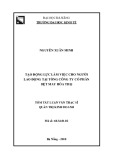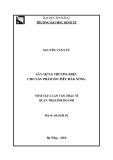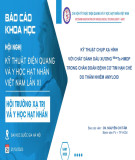
Implementation
Science
Beune et al. Implementation Science 2010, 5:35
http://www.implementationscience.com/content/5/1/35
Open Access
SHORT REPORT
© 2010 Beune et al; licensee BioMed Central Ltd. This is an Open Access article distributed under the terms of the Creative Commons
Attribution License (http://creativecommons.org/licenses/by/2.0), which permits unrestricted use, distribution, and reproduction in
any medium, provided the original work is properly cited.
Short report
Pilot study evaluating the effects of an intervention
to enhance culturally appropriate hypertension
education among healthcare providers in a
primary care setting
Erik JAJ Beune*
†1
, Patrick JE Bindels
2
, Jacob Mohrs
1
, Karien Stronks
3
and Joke A Haafkens*
1
Abstract
Background: To improve hypertension care for ethnic minority patients of African descent in the Netherlands, we
developed a provider intervention to facilitate the delivery of culturally appropriate hypertension education. This pilot
study evaluates how the intervention affected the attitudes and perceived competence of hypertension care providers
with regard to culturally appropriate care.
Methods: Pre- and post-intervention questionnaires were used to measure the attitudes, experienced barriers, and
self-reported behaviour of healthcare providers with regard to culturally appropriate cardiovascular and general care at
three intervention sites (N = 47) and three control sites (N = 35).
Results: Forty-nine participants (60%) completed questionnaires at baseline (T0) and nine months later (T1). At T1,
healthcare providers who received the intervention found it more important to consider the patient's culture when
delivering care than healthcare providers who did not receive the intervention (p = 0.030). The intervention did not
influence experienced barriers and self-reported behaviour with regard to culturally appropriate care delivery.
Conclusion: There is preliminary evidence that the intervention can increase the acceptance of a culturally appropriate
approach to hypertension care among hypertension educators in routine primary care.
Background
In Western countries, ethnic minority populations of
African descent have higher rates of hypertension and
worse hypertension-related health outcomes than Euro-
peans [1-3].
This has also been observed among Afro-Surinamese
(hereafter, Surinamese) and Ghanaians living in the Neth-
erlands. A recent study conducted in Amsterdam
reported a higher prevalence of hypertension in Surinam-
ese (47%) than in ethnically Dutch people (33%). Treat-
ment rates were the same for both groups, but
Surinamese who were treated for hypertension had lower
rates of blood pressure control [4], which may explain the
excess mortality due to stroke found in this group [5].
Hypertension is also highly prevalent among Ghanaians
[6,7].
Poor adherence to antihypertensive medication and
therapeutic lifestyle changes is an important modifiable
factor contributing to ethnic disparities in blood pressure
control [8,9]. There is evidence that patients' health
beliefs can be an important barrier to adherence [10-12],
and that culture can influence those beliefs [13-17]. This
was also found in our own studies of Surinamese, Ghana-
ian, and ethnically Dutch hypertensive patients living in
the Netherlands [18-20].
Hypertension guidelines recommend patient education
as a tool for improving adherence [21,22]. There is some
evidence that culturally appropriate educational inter-
ventions can improve treatment outcomes in ethnic
* Correspondence: e.j.beune@amc.uva.nl, j.a.haafkens@amc.uva.nl
Department of General Practice/Clinical Methods and Public Health, Academic
Medical Centre, University of Amsterdam, Meibergdreef 15, Amsterdam, The
Netherlands
† Contributed equally
Full list of author information is available at the end of the article

Beune et al. Implementation Science 2010, 5:35
http://www.implementationscience.com/content/5/1/35
Page 2 of 10
minority patients [23,24]. However, the literature pro-
vides no descriptions of those interventions for hyperten-
sive patients [25,26].
For this reason, we developed an intervention to facili-
tate the delivery of culturally appropriate hypertension
education (CAHE) by primary care providers. In a previ-
ous study, we identified two barriers that may prevent
healthcare providers from using CAHE: a negative atti-
tude towards culturally appropriate care in general and a
lack of the skills needed to implement this type of health
education [27]. Thus, we conducted a pilot with the aim
of evaluating whether the intervention could remove
these barriers.
Methods
Study design, setting, and participants
We used a quasi-experimental design, contrasting inter-
vention and control groups, to evaluate the effects of the
intervention (see Figure 1). The study was conducted in
six primary care health centres (PCHCs) belonging to the
GAZO healthcare consortium in southeast Amsterdam.
This area was chosen because it has a relatively high pro-
portion of Surinamese and Ghanaian residents. Three of
the selected PCHCs had also participated in a previous
study [18-20,27], and they volunteered to pilot the inter-
vention. The three other PCHCs served as control cen-
tres. It is estimated that 26% of the 24,094 patients
registered in the intervention centres and 26% of the
20,076 patients registered in the control centres are of
Surinamese or Ghanaian origin (data are from 2007).
Based on data from the SUNSET study [4], we expected
that some 47% of the patients of African origin would suf-
fer from hypertension.
All six centres used a similar protocol for hypertension
care, based on the guidelines of the Dutch College of
General Practitioners [21]. According to this protocol,
hypertension education for patients with uncomplicated
hypertension can be provided by a general practitioner
(GP), a nurse practitioner (NP), or a general practice
assistant (GP assistant) under the supervision of a GP.
The intervention targeted all healthcare providers who
provide hypertension education to patients with uncom-
plicated hypertension (K86). The intervention group con-
sisted of 47 healthcare providers: 7 NPs, 18 GP assistants
and 22 GPs. The control group consisted of 35 healthcare
providers: 5 NPs, 14 GP assistants and 16 GPs.
Intervention
The aim of the intervention was to support healthcare
providers in using CAHE, specifically for Surinamese and
Ghanaian patients. Interventions are more likely to elicit
change in healthcare professionals if they use multiple
approaches [28,29]. Our intervention consisted of three
components: written tools, training, and feedback.
Written tools
We supplemented the standard hypertension protocol
used by the intervention centres with information about
six tools to support CAHE:
1. A topic list to explore the patient's ideas, concerns,
and expectations regarding hypertension and hyper-
tension treatment.
2. A topic list to explore culturally specific barriers to
and facilitators of treatment adherence. The items on
the lists were derived from the work of Kleinman
[30,31], recent approaches to improve adherence
[10,32,33], and our prior study [18-20] (see Table 1).
3. A checklist to facilitate the recognition of specific
barriers to hypertension management in Surinamese
and Ghanaian patients, based on our prior study [18-
20].
4. Information leaflets for Surinamese or Ghanaian
patients with answers to frequently asked questions
about hypertension. These leaflets were adapted to
the language, customs, habits, norms, and dietary cul-
tures of the Surinamese and Ghanaian communities,
using information obtained from our previous study
[18-20]. Consideration was also given to recom-
mended surface and deep structure elements [34].
The leaflets were pre-tested in two focus groups with
Surinamese and Ghanaian hypertensive patients.
5. A referral list, including neighbourhood facilities
offering healthier lifestyle support tailored to Suri-
namese and Ghanaian patients.
6. A list of items used to register the results of hyper-
tension counselling sessions.
Information about these tools was made available on
paper and also through pop-up screens in the digital
hypertension protocol used by the intervention centres.
Training and feedback
To support the use of these tools, we provided a training
course of two half-day sessions to all NPs and GP assis-
tants in the intervention centres. During the first session,
information about the prevalence and treatment of
hypertension among populations of African origin in
Western countries was provided and discussed. There
was also discussion of how the tools might be used. Dur-
ing the second session, training was given in culturally
sensitive counselling skills through role-playing exercises
with Surinamese and Ghanaian hypertensive patients.
Educational materials consisted of a course manual and
instruction on the use of the new tools. As a second sup-
portive intervention the researcher (EB) organised feed-
back meetings (lasting 1.5 hours) with the NPs and GP
assistants once every two months.
NPs and GP assistants could also ask for individual
advice. The GPs were invited to an information meeting
at their health centre (lasting one hour) at the start of the

Beune et al. Implementation Science 2010, 5:35
http://www.implementationscience.com/content/5/1/35
Page 3 of 10
Figure 1 Overview of the implementation and the measurement.
Usual Care
Assessment of response change (T1-T0):
- Self-reported attitudes towards culturally appropriate care
- Experienced barriers towards culturally appropriate health care in general
- Experienced barriers towards culturally appropriate cardiovascular care and education
- Self reported actions in delivering culturally appropriate care
Intervention
Hypertension care providers receive:
- Written information about six
tools to support culturally
appropriate HTN education
- Information meetings (GPs)
- Training in culturally
appropriate HTN education
(NPs and GP assistants)
- Feedback meetings (NPs and
GP assistants)
3 Usual Care Sites (N = 35)
Response: N = 23 (66%)
3 Intervention Sites (N = 47)
Response: N = 45 (96%)
T0: Collect baseline data among all GPs, NPs, and GP-assistants (N = 82) on self-reported attitudes, experienced
barriers, and self-reported behaviour with regard to culturally appropriate care delivery
3 Usual Care Sites (N = 23)
Response: N = 17 (74%)
3 Intervention Sites (N = 45)
Response: N = 32 (71%)
T1: Collect data among GPs, NPs, and GP-assistants (N = 68) on self-reported attitudes, experienced barriers,
and self-reported behaviour with regard to culturally appropriate care delivery at nine months.
Six primary care health centres selected
- 3 usual care sites
-
3 intervention sites

Beune et al. Implementation Science 2010, 5:35
http://www.implementationscience.com/content/5/1/35
Page 4 of 10
project and received feedback after every group meeting
with the NPs and GP assistants.
Implementation of the intervention
Implementation started in April 2007 with the training
course for NPs and GP assistants. The GPs were not
invited because almost all of them had completed a some-
what similar training, organised by the PCHCs at an ear-
lier stage. After the training, the tools for CAHE were
made available on paper to the healthcare providers. Two
and four months later, these tools could also be accessed
through the digital hypertension protocol on the PCHC
intranet portal. Technical circumstances delayed the
intranet access to this protocol. During follow-up, five
information meetings for GPs and seven feedback meet-
ings for NPs and GP assistants were held and individual
coaching sessions on request.
Measurement
A questionnaire was used to evaluate the extent to which
the intervention had been able to remove previously
observed barriers to the provision of culturally appropri-
ate hypertension care (negative attitudes and a lack of
perceived competence). We used the 'Resident Physicians'
Preparedness to Provide Cross-Cultural Care' survey for
this purpose [35]. This instrument was used previously to
measure effects of cross-cultural training among physi-
cians in academic health centres. It measures attitudes
and perceived competence with regard to culturally
appropriate healthcare in general. Because we were par-
ticularly interested in cardiovascular care, we adapted
this instrument for the purpose of our study. Our ques-
tionnaire consisted of four scales. Each scale contains a
number of items (questions) to measure a single con-
struct. Scale one measures attitudes towards delivering
culturally appropriate care (six items), scale two measures
the experienced barriers to the delivery of culturally
appropriate care in general (nine items), scale three mea-
sures the experienced barriers to the delivery of culturally
appropriate cardiovascular care and education (eight
items), and scale four measures the self-reported actions
in delivering culturally appropriate care (17 items).
Respondents had to answer the questions by picking a
response option on a four- or five-point Likert scale,
which is a commonly used instrument in psychological
research on attitudes and self-reported behaviours.
Measurements were performed in April 2007 before
the training course was given (T0), and nine months later
(T1). On both occasions, the questionnaires were distrib-
uted with an explanatory covering letter. Reminders were
sent two and four weeks later.
Data analysis
Completed questionnaires were entered into SPSS Data
Entry 4.0 (Ref: SPSS Inc, Chicago IL, USA) and checked
for errors using a random test. A first analysis of the data
revealed that some of the questions included in the ques-
tionnaire could not be answered by NPs and GP assis-
tants, because they were not applicable to their work
(three, three, and two items of scales two, three, and four,
Table 1: Topic list for eliciting immigrant patients'
explanatory model of hypertension1
Communication
Determine how a patient wants to be addressed (formally or
informally).
Determine the patient's preferred language for speaking and
reading (Dutch or another language).
Use this information in your interaction with the patient.
Introduction
It is often difficult for us (care providers) to give advice about
hypertension and how to manage it if we are not familiar with the
views and experiences of our patients. For that reason, I would like to
ask you some questions to learn more about your own views on
hypertension and its treatment.
Topic list one: Elicit personal views on hypertension and its
treatment
Understanding
What do you understand hypertension to mean?
Causes
What do you think has caused your hypertension? Why did it occur
now/when it did; why to you?
Meaning and symptoms
What does it mean to you to have hypertension?
Do you notice anything about your hypertension? How do you react
in this case?
Duration and consequences
How do you think your hypertension will develop further? How
severe is it?
What consequences do you think your hypertension may have for
you (physical, psychological, social)?
Treatment
What types of treatment do you think would be useful?
What does the prescribed therapeutic measurement(s) mean to you?
Topic list two: Elicit contextual influences on hypertension
management
Social
Do you speak with family/community members about your
hypertension? How do they react?
Do family/community members help you or make it difficult for you
to manage hypertension? Please explain.
Culture/religion
Are there any cultural issues/religious issues that may help you or
make it difficult for you to manage hypertension? Please explain.
Migration
Are there any issues related to your position as an immigrant that
make it difficult to you to manage hypertension? Please explain.
Finance
Are there any issues related to your financial situation that make it
difficult for you to manage hypertension? Please explain.
1Based on Kleinman's Explanatory Model format [30,31] and our
previous study [18-20].

Beune et al. Implementation Science 2010, 5:35
http://www.implementationscience.com/content/5/1/35
Page 5 of 10
respectively). This could be explained by the fact that the
original instrument had only been tested among physi-
cians, but not among nurses. These items were removed.
With the remaining items, we reconstructed the four
scales of the questionnaire, using principal component
analysis. These scales were consistent and, based on
Cronbach's alpha scores, the psychometric characteristics
of the scales were good (see Table 2).
To reduce the effect of confounding factors, the final
data analysis was only based on observations from partic-
ipants who completed the questionnaires twice, at T0 and
at T1.
To review response changes, we computed the mean
scores and standard deviations of the respondents at T0
and T1 for each of the four scales. Differences in scores
between the intervention and the control groups at T0
and T1 were tested using one-way analysis of variance for
the four scales. To correct for confounding effect of the
higher baseline scores of the intervention group at scale
four, an additional regression analysis was performed.
Test-statistics with a p-value of less than 0.05 were con-
sidered statistically significant. All statistical analyses
were performed using SPSS version 16.0 (SPSS Inc, Chi-
cago IL, USA).
Ethics
The study protocol was submitted to the Medical Ethical
Committee of the Academic Medical Centre of the Uni-
versity of Amsterdam. The Committee established that
the study does not fall within the realm of the Dutch Law
Medical Scientific Research with humans because it does
not include a medical intervention or invasive measures
with humans. For that reason, the Committee sent a letter
stating that the study does not require further assessment
and approval from the Medical Ethical Committee of the
Academic Medical Centre (AMC) of the University of
Amsterdam or from any other officially accredited Medi-
cal Ethical Research Committee in the Netherlands (ref-
erence number 09171260). However, in line with the
AMC code for the good conduct of medical research [36],
provisions were made to assure the respondents anonym-
ity in collection, analysis, and presentation of the data.
Results
All but two of the 25 invited NPs and GP assistants (92%)
from the intervention PCHCs attended the training
course. After the training course, 18 of the 22 GPs in the
intervention group (82%) attended information meetings;
16 of the 25 NPs and GP assistants (64%) attended feed-
back meetings and seven of them (28%) had asked for
individual coaching sessions.
A total of 82 questionnaires were sent out at baseline
(T0), 47 to the intervention group and 35 to the control
group. Forty-nine participants (60%) completed the ques-
tionnaires both at baseline (T0) and nine months later
(T1), 32 (68%) in the intervention group and 17 (49%) in
the control group.
The characteristics of the respondents are displayed in
Table 3. The mean age of those who completed both
questionnaires was 47 years, the majority were female
(80%) and had a Dutch ethnic background (81%). These
characteristics did not differ much between the interven-
tion and control groups.
Table 4 shows the mean scores of the respondents of
the intervention and control groups and the results of the
ANOVA analysis on each of the four scales at T0 and at
T1. At baseline, no significant differences were found
between both groups with respect to the attitudes
towards culturally appropriate care (scale one) and the
perceived barriers for delivering it (scale two and three).
The baseline scores on scale four were significantly
higher in the intervention group compared to the control
group (p = 0.012). This indicates that, at the start of the
project, the intervention group more often considered a
patient's cultural background while delivering care than
the control group. At T1, healthcare providers who
received the intervention found it more important to
consider the patient's culture when delivering care than
healthcare providers who did not receive the intervention
(scale one, p = 0.030). No significant differences were
found for: scale two, experienced barriers in delivering
culturally appropriate care in general; scale three, experi-
enced barriers towards culturally appropriate cardiovas-
cular care and education; and scale four, self-reported
culturally appropriate healthcare behaviour. Because the
higher baseline scores on scale four at T0 in the interven-
tion group might be a confounder, we have corrected for
this variable in an additional regression-analysis. After
this correction, the important and significant effect from
the intervention on 'scale one: attitude towards culturally
appropriate care' at T1 remained and was even stronger
(p = 0.013).
Discussion
We described a pilot study of an intervention to assist
healthcare providers in delivering CAHE. Inspired by evi-
dence from studies on professional behaviour change
[28,29], the intervention consisted of multiple compo-
nents: tools for CAHE that complemented an existing
digital protocol for hypertension care, training, and feed-
back possibilities. Moreover, the content of the tools and
the supportive interventions were aimed at removing pre-
viously observed barriers that may impede CAHE--a neg-
ative attitude towards culturally appropriate care and/or
insufficient competence to implement it.
The results revealed that healthcare professionals who
participated in the intervention considered it more
important to address the patient's culture when deliver-










![Hình ảnh học bệnh não mạch máu nhỏ: Báo cáo [Năm]](https://cdn.tailieu.vn/images/document/thumbnail/2024/20240705/sanhobien01/135x160/1985290001.jpg)















